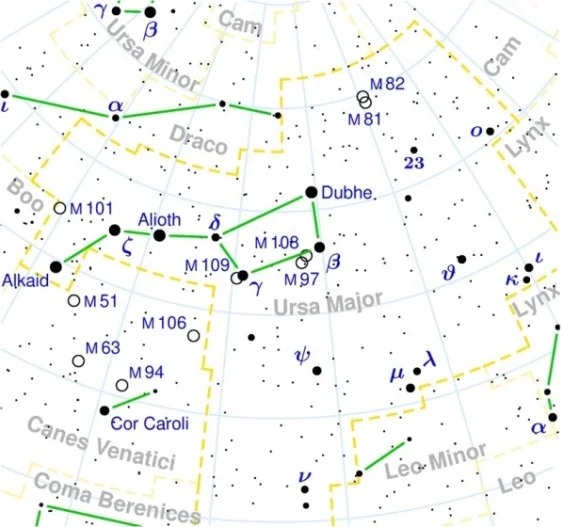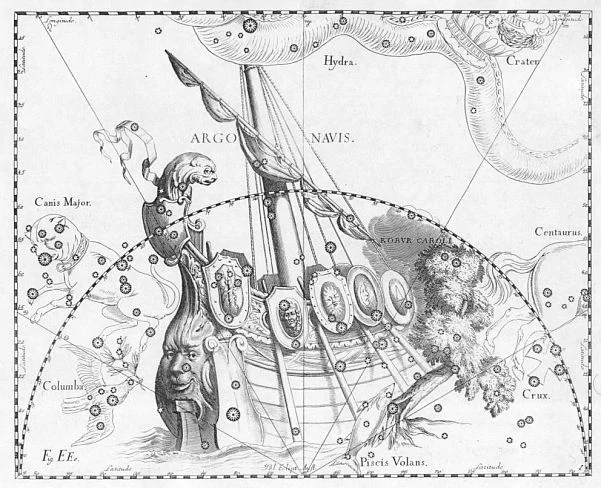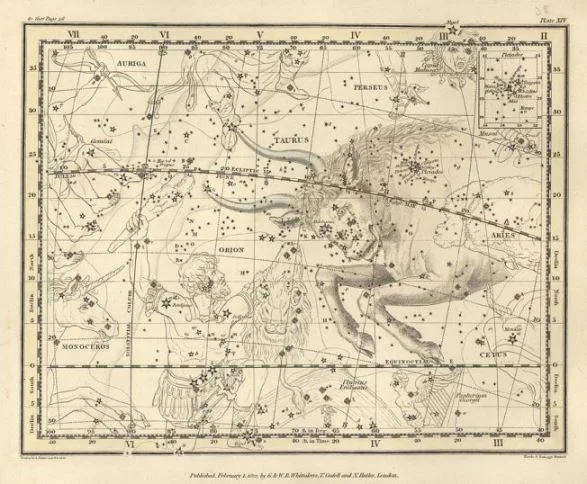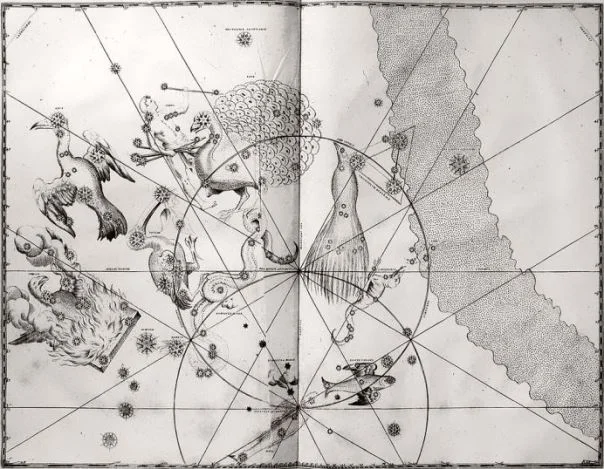A constellation is an area of the celestial sphere as defined by the International Astronomical Union (IAU) in the early 20th century. Constellations are used for orientation and arranged in a grid-like map of the sky. They are typically grouped around asterisms, patterns formed by bright stars that appear close to each other in the night sky.
While modern star constellations are defined as areas of the sky and not star patterns, historically the term constellation was commonly used for asterisms formed by the constellations’ brightest stars. These asterisms are often the most conspicuous parts of constellations, which is why the term constellation is still colloquially (and incorrectly) used synonymously with asterism.
The constellations themselves are much larger than asterisms and occupy considerably larger areas. For example, the Big Dipper, Little Dipper and Southern Cross are not constellations. They are asterisms formed by the brightest stars of the constellations Ursa Major, Ursa Minor, and Crux.

Ursa Major and the Big Dipper, map by Torsten Bronger (CC BY-SA 3.0)
The borders of the modern 88 constellations were defined by the IAU in the early 20th century. 48 of the modern constellations, mainly those visible in the northern hemisphere, are based on the Greek constellations, catalogued by the astronomer Claudius Ptolemy in the 2nd century CE.
The celestial sphere was divided into 88 official constellations in 1922 by the IAU with the help of American astronomer Henry Norris Russell. In 1930, Belgian astronomer Eugène Delporte devised the boundaries between the modern constellations along horizontal and vertical lines. Delporte based his work on that of Benjamin A. Gould.
Most of the modern 88 constellations have kept the names of their predecessors, the 50 ancient constellations that were known in ancient Greece, Rome and the Middle East, and the 38 constellations that were created more recently.
However, many other constellations were created over the millennia, and they differed from one culture to the next. Some of these historical constellations were not widely recognized and fell out of use, while others were split into smaller areas of the sky. For instance, Quadrans Muralis, a constellation created in 1795, was later divided between Draco and Boötes, with the name preserved only in the Quadrantids meteor shower.

The image shows Argo Navis constellation as depicted in Uranographia by Johannes Hevelius. The view is mirrored following the tradition of celestial globes, showing the celestial sphere in a view from “outside.”
The Greek constellation Argo Navis, which represented the ship of Jason and the Argonauts, was divided by the French astronomer Nicolas Louis de Lacaille into Carina, Vela, and Puppis, three smaller constellations representing the ship’s keel, sails, and stern respectively. The new division was introduced in 1763, in the star catalogue Coelum Australe Stelliferum, published after de Lacaille’s passing.
Today, when talking about stars and deep sky objects being ‘in’ a given constellation, astronomers mean to say that they lie within the defined boundaries of the constellation. Constellations themselves are not real, since the stars and deep sky objects (nebulae, galaxies, clusters) belonging to them lie at very different distances from Earth and only appear close to one another because they lie in the same line of sight when seen from Earth.
Since the stars and other visible objects are located at different distances, this also means that we are seeing them as they were at very different points in the past and not as they appear now. Antares in Scorpius, for instance, lies about 550 light years from Earth. We are therefore seeing it as it appeared some 550 years ago. The Trifid Nebula in Sagittarius is approximately 4,100 light years distant, so the image we are seeing is 4,100 years old. Galaxies lie at even greater distances. The famous Antennae Galaxies in Corvus are located some 45 million light years from Earth. This makes the images of the colliding pair 45 million years old.
Constellation definition
Merriam-Webster dictionary defines the constellation as “a group of stars that forms a particular shape in the sky and has been given a name” or “any of 88 arbitrary configurations of stars or an area of the celestial sphere covering any of these configurations.”
Britannica defines the term, as used in astronomy, as “any of certain groupings of stars that were imagined – at least by those who named them – to form conspicuous configurations of objects or creatures in the sky.”
While there may be no distinction in colloquial usage, strictly speaking any definition equating constellations with star patterns is incorrect. While the constellations started out as conspicuous asterisms, the term now primarily denotes areas of the sky.
Constellation history
In ancient times, observers saw distinctive, identifiable patterns of stars in the night sky, now called asterisms, and made up different kinds of stories that they associated with them. Orion, the Hunter and Taurus, the Bull, for instance, were known to many cultures since antiquity and associated with a number of different legends. Once the first astronomers started creating star maps, the most familiar asterisms were included in the maps and became the first constellations.

Orion and Taurus. Plate 14 from A celestial atlas comprising a systematic display of the heavens in a series of thirty maps illustrated by scientific description of their contents and accompanied by catalogues of the stars and astronomical exercises. Image: Alexander Jamieson
The word constellation is derived from the Latin constellātiō, which can be translated as “set with stars.” The term comes from astrology, and was first used for asterisms that were believed to exert astrological influence, as noted by Roman soldier and historian Ammianus Marcellinus in the 4th century.
In the English language, the word was also initially used in astrology, from the 14th century onwards. It referred to conjunctions of planets. The term was not used in the modern sense – to refer to an area of the celestial sphere – until the mid-16th century.
The 48 Greek constellations listed by Ptolemy, which formed the basis for the modern division, were based on the work of the Greek astronomer Eudoxus of Cnidus, who is credited for introducing Babylonian astronomy to Greece in the 4th century BC. 30 of these constellations date back to earlier times. Some of them, including the constellations of the zodiac, have a history going all the way back to the Late Bronze Age.
Greek astronomers adopted Babylonian astronomy and, as a result, some of the Greek constellations contained the same stars as Babylonian ones. They were only listed under different names. The Almagest served as a basis for astronomy as taught from late antiquity to the early modern period in the west.
Many of the southern stars could not be seen by the Greeks, Babylonians, Arabs, Chinese, or any other culture north of the equator. For this reason, many of the modern southern constellations were not created until the age of exploration. The southern stars were charted by Dutch navigators Frederick de Houtman and Pieter Dirkszoon Keyser in the late 16th century and the new constellations included in Johann Bayer’s star atlas Uranometria (1603).

A print of the copperplate engraving for Johann Bayer’s Uranometria (1661 edition) showing the 12 new southern constellations. This image is courtesy of the History of Science Department at the University of Oklahoma.
Bayer added 11 new constellations, including Tucana, Musca, Dorado, Indus and Phoenix. He also assigned Greek letters to a total of 1,564 stars in different constellations. The stars were given Greek letter designations in the order of magnitude, starting from Alpha. The Bayer designations have mostly been kept until present day. Out of about 10,000 visible stars, 1,564 have Bayer designations, consisting of a Greek letter and the name of the constellation in genitive form (Alpha Centauri, Beta Tauri, Gamma Aquilae, etc.) Some of these stars also have proper names since they were bright enough to be seen by ancient observers and spark their imagination, so we know Alpha Scorpii as Antares, Alpha Aquilae as Altair, Alpha Canis Majoris as Sirius, Alpha Orionis as Betelgeuse, and Alpha Tauri as Aldebaran, to only name a few.
Several more constellations were added by the French astronomer Nicolas Louis de Lacaille in his catalogue published in 1756. Lacaille created 14 new constellations while mapping the southern skies from an observatory in South Africa. Lacaille’s constellations include Octans, Fornax, Pictor, Antlia and Mensa, the last of which was named after Mons Mensa, or Table Mountain, which is where his observatory was located.
The International Astronomical Union, formed in 1919, set out to define the official boundaries between the constellations in the 1920s. Eugène Delporte adjusted the modern boundaries along the lines of right ascension and declination for the epoch B1875.0. Due to the precession of the equinoxes, the boundaries will eventually have to be re-adjusted.
Out of the official 88 constellations, 36 are found in the northern sky and the remaining 52 in the southern.